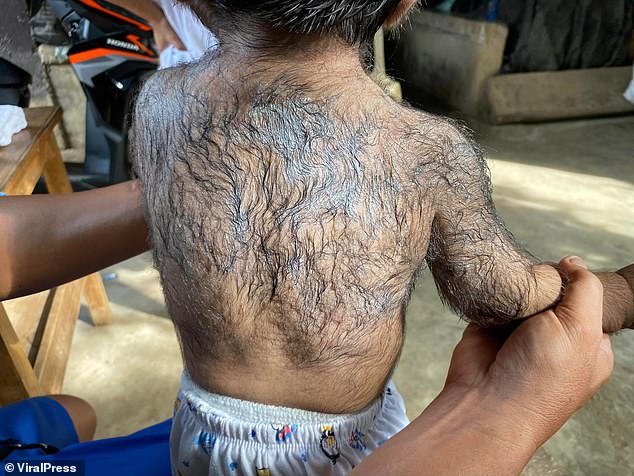Concerns over babies developing bizarre ‘werewolf syndrome’ after parents use a popular hair loss drug



A popular hair loss drug could be causing babies to suffer from ‘warewolf syndrome’, leaving them covered in hair, Spanish health chiefs have warned.
Nearly a dozen cases have been reported in Europe since 2023.
Officials believe the newborns developed the condition after their parents used the over-the-counter drug minoxidil, which is commonly applied to the scalp to stimulate hair growth.
‘Werewolf syndrome’ causes abnormal amounts of fine hairs up to 5cm in length to grow on a person’s face, arms and other parts of their body.
Medically known as hypertrichosis, there is no cure, meaning people must manage the symptoms by shaving, waxing or cutting the hair.
According to the Pharmacovigilance Center of Navarra – a province in northern Spain – concerns about the bizarre phenomenon first arose in April 2023, after a baby boy started developing hair on his back, legs and thighs for two months.
Health experts discovered that his father, who had not worked for a month to care for him, had used a five percent minoxidil lotion on his scalp to treat baldness.
However, when the baby was no longer exposed to this drug, his symptoms subsided.

‘Werewolf syndrome’ causes abnormal amounts of fine hairs up to 5cm long to grow on a person’s face, arms and other parts of their body. Stock image

Minoxidil, marketed under the brand name Regaine in Britain, comes in foam or liquid form in a strength of two or five percent
Minoxidil, marketed in Britain under the brand name Regaine, comes in foam or liquid form in a strength of two or five percent.
It is available without a prescription on Amazon and in most pharmacies.
The drug works by increasing blood flow to the hair follicles – the part of the skin where a hair grows by packing old cells together.
Following the case, the Navarra Medicines Agency subsequently assessed the Spanish Pharmacovigilance System and the European Medicines Agency’s EudraVigilance databases.
According to the Spanish newspaper El Economistathey discovered ten other recent cases of ‘werewolf syndrome’ in babies in Europe linked to minoxidil.
In all cases, symptoms improved after the parent stopped using minoxidil.
However, the health agency warned that very young babies exposed to the drug could be at risk of damage to their heart and kidneys.
Previous research has also shown that even a teaspoon placed on an adult’s scalp twice a day can cause rapid heart rate and problems with salt and water retention.
In its report, the Navarra Medicines Agency said minoxidil was likely passed from parents to their babies through the skin or mouth.
Because the medicine is applied directly to the skin, a baby may be exposed if he tries to suck or chew his parent’s head or hands after they apply the medicine.
In light of these incidents, minoxidil sold in Europe will now have to carry warnings on the packaging about the risk of hypertrichosis in infants, advising users to avoid contact with young children in the areas where the drug has been applied.
In 2019, at least 17 children in Spain, including some infants, developed ‘werewolf syndrome’ after a hair loss treatment was accidentally put into bottles containing reflux medication.
The children started growing hair all over their bodies after being given omeprazole, a drug that helps with acid reflux.
But after investigating, authorities discovered that the treatment actually contained minoxidil.
At the time, Health Minister Maria Luisa Carcedo said they discovered that the defective batches came from a laboratory that had “put this drug (minoxidil) in a container marked as omeprazole” and distributed it as such to pharmacies.
It comes as minoxidil took the internet by storm earlier this year after social media users discovered it could act ‘like fertilizer for your eyebrows’.
When used two to three times a week, the drug “significantly” improves eyebrow hair growth, proponents say.
However, other doctors warned that the treatment is not approved for this use and, ironically, can even cause side effects, including hair loss, if used incorrectly.
The NHS also advises that minoxidil is only intended to treat hair loss in men and women that has a family history.
It is not intended to treat hair loss caused by other factors, including stress, illness or even iron deficiency.




